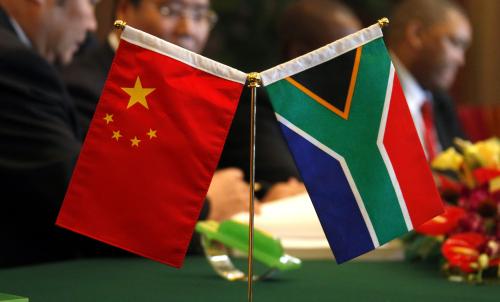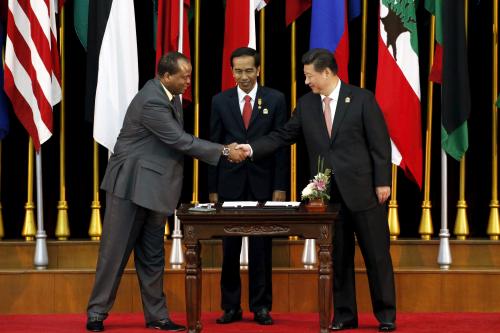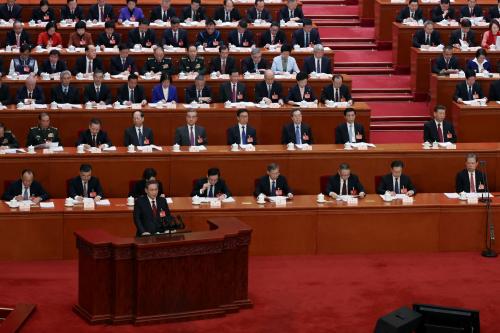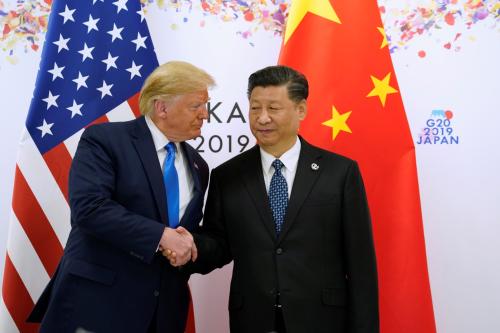Content from the Brookings-Tsinghua Public Policy Center is now archived. Since October 1, 2020, Brookings has maintained a limited partnership with Tsinghua University School of Public Policy and Management that is intended to facilitate jointly organized dialogues, meetings, and/or events.
On July 29, 2016, the Forum on China-Africa Cooperation (FOCAC) held the “Coordinators’ Meeting on the Implementation of the Follow-up Actions of the Johannesburg Summit” in Beijing. The meeting, which centered on the ten major China-Africa cooperation programs1 proposed by President Xi Jinping during the Johannesburg Summit last year, aimed to deliver real results from cooperation and, thus, elevate the Africa-China strategic partnership to a new level. As the first such gathering focused on implementing follow-up actions, the Coordinators’ Meeting partially mitigated doubts surrounding the Chinese government’s public pledges of aid and cooperation that, in many nations, do not always turn into real projects.2
Admittedly, questions still remain. Compared to funding from the Development Assistance Committee (DAC),3 which is more familiar to Western audiences, the very definition of Chinese foreign assistance seems to be muddled. However, as the largest economy providing assistance outside of the DAC paradigm, China is actually not all that different—or, at least, it is becoming increasingly similar.
China and the DAC: Similar beginnings
Chinese foreign assistance has undergone several transformations since the 1950s. Before 1973, China provided sets of equipment entirely in grant form. Throughout that period, China’s foreign aid expense relative to gross national income (GNI) averaged 1.07 percent.4 This level of aid satisfied the World Council of Churches’ target, which all DAC members subscribed to during the 1960s: based on total flows of both official and private resources, 1 percent of donor countries’ incomes should go to developing countries.5
However, as a newly established regime, China’s foreign assistance expenses soon exceeded its domestic financial capacity. Starting in 1973, in order to cope with cuts to its domestic budget and prioritize the development of its domestic economy, Chinese foreign assistance evolved to include areas of mutual benefit, such as trade, joint-investment, and so on, gradually transforming into its current model of economic cooperation.
As a recipient of foreign assistance, China is drawing lessons from its own experience of modernization centered on industrialization. Chinese foreign assistance today is provided mostly on a state-to-state basis, concentrated in physical infrastructure construction, and aimed at continuous access to natural resources and overseas markets. This differs significantly from the current DAC system, in which member countries allocate more than 80 percent of assistance to public health and education, and generally collaborate with civil society to provide and implement assistance. However, when taking into account the evolution of foreign assistance patterns over time, China and the DAC share major similarities.
In the 1960s, influenced by John Maynard Keynes’s theory of the welfare state and W.W. Rostow’s “stages of economic development” concept, the United Nations, the World Bank, and the newly formed U.S. Agency for International Development started allocating development aid in a manner that encouraged macro-economic planning with close involvement from state enterprises, government institutions, and so on.6 These three institutions also stressed that development would be a long-term effort requiring country-by-country planning and the commitment of resources on a multi-year, programmed basis.7
The linear stages of growth theory, which these institutions adapted into their own model, assumes that economic growth can only be achieved through industrialization. The idea is that the development of physical infrastructure—like roads, dams, and telecommunications equipment—enables economic benefits to “trickle down” to other sectors, spurring the training and migration of rural laborers.8DAC’s motivation throughout the 1960s (albeit unofficially) was “promoting the economic and commercial interests, including continued access to natural resources, raw materials, and markets in the former colonies.”9
Like DAC assistance, Chinese foreign assistance increasingly targets recipients’ welfare
Since the early 1970s, the central focus of foreign assistance provided by DAC members has shifted to the poorest sectors of developing nations—or “basic human needs,” which includes agriculture, family planning, and education. Since the 1990s, for instance, as the largest contributor of global official development assistance, the United States has sharply increased its funding for poverty-focused “core accounts,” including Global Health, Development Assistance, Millennium Challenge Corporation, Disaster Assistance, Migration and Refugee Assistance, and Food Aid.10
China is exploring a much clearer division between business and aid. Since the 1990s, China has increasingly utilized regional frameworks—such as the Shanghai Cooperation Organization (SCO), the Central Asia Regional Economic Cooperation (CAREC), the South Asian Association for Regional Cooperation (SAARC), the FOCAC, and the “One Belt, One Road” Initiative—to pledge large-scale loans, including foreign aid.11As the Ministry of Foreign Affairs of the People’s Republic of China formally announced after the Coordinators’ Meeting, investment cooperation is replacing assistance to become the new engine of China-Africa cooperation.12 It is reasonable to expect that the organizations and enterprises affiliated with regional economic cooperation will take over less-concessional commercial activities. Meanwhile, with the establishment of the South-South Cooperation and Assistance Fund, which is designed to improve the livelihoods of people in recipient countries, the Department of Aid to Foreign Countries under the Ministry of Commerce (MOFCOM) is very likely to focus more on improving the welfare of recipient nations’ populations, with the involvement of domestic non-governmental organizations and other private sector partners.
Gaps still exist, but they are narrowing
In terms of performance, China has been attempting to glean best practices from multilateral institutions and DAC member countries in order to strengthen its own implementation structure and the quality of its foreign aid,13 but a gap still exists. Although data transparency and information disclosure have been the focus of attention, a root cause underlying the performance gap is the relative lack of coordination between different ministries, enterprises, and localities. As Lieberthal and Wang (2012) point out, the conflicting outcomes that result from poor coordination are “often seen as part of a seamless web of Politburo Standing Committee policy designed to confuse and deceive American policy makers.”14 With different, unconnected information systems in use across ministries and departments, gathering and reporting relevant data requires tremendous effort and coordination. Furthermore, foreign assistance is categorized as a state secret in China, which further contributes to misunderstanding and suspicion among outsiders.
Since 2006, eight mechanisms of communication and coordination have been set up to link 23 ministries and 14 departments in MOFCOM. In April 2011, the first white paper on China’s foreign aid was published. In 2013, MOFCOM took another step forward by reporting the previous year’s activities of the Department of Aid to Foreign Countries and three affiliated organizations (the Executive Bureau of International Economic Cooperation, the China International Center for Economic and Technical Exchanges (CICETE), and the Academy for International Business Officials (AIBO)). However, more progress should be achieved and made visible. In particular, as China invites civil society to participate in pledging and providing development finance, information disclosure is crucial to establishing the government’s own credibility and accountability.
In addition to improving transparency, China should define and explain the theoretical basis underlying its existing foreign assistance. To demonstrate that it is a responsible great power, China has shown its willingness to contribute more to global development. The Chinese Communist Party’s 13th Five-Year Plan states that China will more actively participate in global governance, including by enhancing cooperation and assistance. However, it is urgent for academics and policy-makers to design and enact permanent foreign aid authorization laws, as the United States did with the Foreign Assistance Act of 1961. Moreover, China’s own development experience needs to be organized into a generalized development theory, which would help explain its rationale for focusing foreign assistance on specific areas and lay out its expectation for how that assistance will yield positive results.
Because China observes the Five Principles of Peaceful Coexistence, it imposes no political conditions on recipient countries.15 Although this might remain as the biggest difference between China and some DAC countries, in practice, different players of development assistance can seek and find common ground.
The OECD has proposed a new development finance standard—total official support for sustainable development (TOSSD)16—which it hopes will serve as a universally accepted measure of public financial support for sustainable development.17 TOSSD complements ODA by covering the totality of international public finance extended to developing countries and multilateral institutions, regardless of the type of instrument used and the associated terms. TOSSD also potentially includes private resources mobilized through public schemes, as well as the activities of diverse financial intermediaries.18 Therefore, China will have a greater incentive to identify and report its development financing, which is left out of the ODA measurement, even as it continues to improve its definition of exactly what falls into this category. Likewise, the successful signing of the Memorandum of Understanding on U.S.-China Development Cooperation (2015) is another positive sign that Chinese foreign assistance and assistance from DAC member countries are becoming increasingly aligned. Further joint efforts between China and other assistance providers can certainly be anticipated in the future.
-
Footnotes
- http://www.focac.org/eng/zfgx/dfzc/t1322068.htm
- http://www.lowyinstitute.org/publications/geopolitics-chinese-aid
- http://www.oecd.org/development/developmentassistancecommitteedac.htm
- Calculated by the author. Annual GNI is extracted on the website of National Bureau of Statistics of China: data.stats.gov.cn; foreign aid expense is extracted from the book Research on China’s Foreign Aid and International Liability. Liu H., Huang M., 2013, published by China Social Science Publishing House.
- http://www.oecd.org/dac/stats/the07odagnitarget-ahistory.htm
- http://www.spitoff.com/readebook-the-politics-of-public-private-partnerships.html. Melkote, S (1991). Communication for development in the third world: Theory and practice. New Delhi-London: Sage
- http://pdf.usaid.gov/pdf_docs/Pnacp064.pdf
- Cairncross, A. K. (1961). The Stages of Economic Growth. The Economic History Review. 13(3): 450-458.
- Degnbol- Martinussen & Engberg-Pedersen, P. (2003). Aid: Understanding international development cooperation. London: Zed Books.
- https://www.fas.org/sgp/crs/row/R40213.pdf pp12
- Kitano., Naohiro, (2014) China’s Foreign Aid at a Transitional Stage, Asian Economic Policy Review, No.9, pp301-317
- http://www.fmprc.gov.cn/mfa_eng/zxxx_662805/t1386331.shtml
- Kitano., Naohiro, (2014) China’s Foreign Aid at a Transitional Stage, Asian Economic Policy Review, No.9, pp301-317
- https://www.brookings.edu/research/addressing-u-s-china-strategic-distrust/
- http://www.fmprc.gov.cn/mfa_eng/ziliao_665539/3602_665543/3604_665547/t18053.shtml
- http://www.oecd.org/dac/financing-sustainable-development/tossd.htm
- https://www.brookings.edu/2016/04/15/dont-tossd-the-baby-out-with-the-bathwater-the-need-for-a-new-way-to-measure-development-cooperation-not-just-another-bad-acronym/
- https://www.oecd.org/dac/financing-sustainable-development/Addis%20flyer%20-%20TOSSD.pdf






Commentary
Op-edHow does Chinese foreign assistance compare to that of developed countries?
August 25, 2016